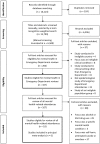Epidemiology of Mental Health Attendances at Emergency Departments: Systematic Review and Meta-Analysis
- PMID: 27120350
- PMCID: PMC4847792
- DOI: 10.1371/journal.pone.0154449
Epidemiology of Mental Health Attendances at Emergency Departments: Systematic Review and Meta-Analysis
Abstract
Background: The characteristics of Emergency Department (ED) attendances due to mental or behavioural health disorders need to be described to enable appropriate development of services. We aimed to describe the epidemiology of mental health-related ED attendances within health care systems free at the point of access, including clinical reason for presentation, previous service use, and patient sociodemographic characteristics.
Method: Systematic review and meta-analysis of observational studies describing ED attendances by patients with common mental health conditions.
Findings: 18 studies from seven countries met eligibility criteria. Patients attending due to mental or behavioural health disorders accounted for 4% of ED attendances; a third were due to self-harm or suicidal ideation. 58.1% of attendees had a history of psychiatric illness and up to 58% were admitted. The majority of studies were single site and of low quality so results must be interpreted cautiously.
Conclusions: Prevalence studies of mental health-related ED attendances are required to enable the development of services to meet specific needs.
Conflict of interest statement
Figures



References
-
- Care Quality Commission. Right here, right now: people’s experiences of help, care and support during a mental heath crisis. London: London: CQC; 2015. June.
-
- NHS Confederation. Briefing: Mental health and crisis care. [Internet]. London: NHS Conferderation; 2014. Available: http://www.nhsconfed.org/~/media/Confederation/Files/Publications/Docume... (Accessed 9 September 2015)
-
- Department of Health. NHS Mandate 2014 to 2015 [Internet]. London: Department of Health; 2013. Available: https://www.gov.uk/government/publications/nhs-mandate-2014-to-2015 (Accessed 9 September 2015)
-
- Fernandes A. Guidance for commissioning integrated urgent and emergency care: a “whole system” approach. London: RCGP Centre for Commissioning; 2011.
-
- Joint Commissioning Panel for Mental Health. Guidance for commissioners of liaison mental health services to acute hospitals. London: Royal College of Psychiatry; 2012.
Publication types
MeSH terms
LinkOut - more resources
Full Text Sources
Other Literature Sources
Medical
Miscellaneous

